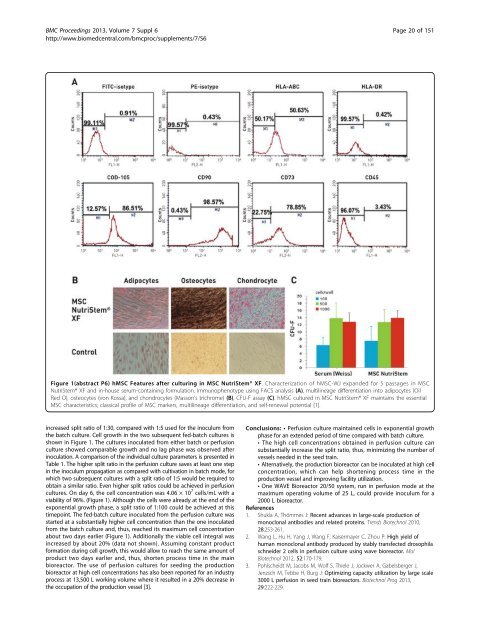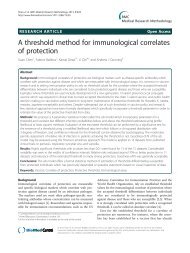Download PDF (all abstracts) - BioMed Central
Download PDF (all abstracts) - BioMed Central
Download PDF (all abstracts) - BioMed Central
Create successful ePaper yourself
Turn your PDF publications into a flip-book with our unique Google optimized e-Paper software.
BMC Proceedings 2013, Volume 7 Suppl 6<br />
http://www.biomedcentral.com/bmcproc/supplements/7/S6<br />
Page 20 of 151<br />
Figure 1(abstract P6) hMSC Features after culturing in MSC NutriStem® XF. Characterization of hMSC-WJ expanded for 5 passages in MSC<br />
NutriStem® XF and in-house serum-containing formulation. Immunophenotype using FACS analysis (A), multilineage differentiation into adipocytes (Oil<br />
Red O), osteocytes (von Kossa), and chondrocytes (Masson’s trichrome) (B), CFU-F assay (C). hMSC cultured in MSC NutriStem® XF maintains the essential<br />
MSC characteristics; classical profile of MSC markers, multilineage differentiation, and self-renewal potential [1].<br />
increased split ratio of 1:30, compared with 1:5 used for the inoculum from<br />
the batch culture. Cell growth in the two subsequent fed-batch cultures is<br />
shown in Figure 1. The cultures inoculated from either batch or perfusion<br />
culture showed comparable growth and no lag phase was observed after<br />
inoculation. A comparison of the individual culture parameters is presented in<br />
Table 1. The higher split ratio in the perfusion culture saves at least one step<br />
in the inoculum propagation as compared with cultivation in batch mode, for<br />
which two subsequent cultures with a split ratio of 1:5 would be required to<br />
obtain a similar ratio. Even higher split ratios could be achieved in perfusion<br />
cultures. On day 6, the cell concentration was 4.06 × 10 7 cells/mL with a<br />
viability of 96%. (Figure 1). Although the cells were already at the end of the<br />
exponential growth phase, a split ratio of 1:100 could be achieved at this<br />
timepoint. The fed-batch culture inoculated from the perfusion culture was<br />
started at a substanti<strong>all</strong>y higher cell concentration than the one inoculated<br />
from the batch culture and, thus, reached its maximum cell concentration<br />
about two days earlier (Figure 1). Addition<strong>all</strong>y the viable cell integral was<br />
increased by about 20% (data not shown). Assuming constant product<br />
formation during cell growth, this would <strong>all</strong>ow to reach the same amount of<br />
product two days earlier and, thus, shorten process time in the main<br />
bioreactor. The use of perfusion cultures for seeding the production<br />
bioreactor at high cell concentrations has also been reported for an industry<br />
process at 13,500 L working volume where it resulted in a 20% decrease in<br />
the occupation of the production vessel [3].<br />
Conclusions: • Perfusion culture maintained cells in exponential growth<br />
phase for an extended period of time compared with batch culture.<br />
• The high cell concentrations obtained in perfusion culture can<br />
substanti<strong>all</strong>y increase the split ratio, thus, minimizing the number of<br />
vessels needed in the seed train.<br />
• Alternatively, the production bioreactor can be inoculated at high cell<br />
concentration, which can help shortening process time in the<br />
production vessel and improving facility utilization.<br />
• One WAVE Bioreactor 20/50 system, run in perfusion mode at the<br />
maximum operating volume of 25 L, could provide inoculum for a<br />
2000 L bioreactor.<br />
References<br />
1. Shukla A, Thömmes J: Recent advances in large-scale production of<br />
monoclonal antibodies and related proteins. Trends Biotechnol 2010,<br />
28:253-261.<br />
2. Wang L, Hu H, Yang J, Wang F, Kaisermayer C, Zhou P: High yield of<br />
human monoclonal antibody produced by stably transfected drosophila<br />
schneider 2 cells in perfusion culture using wave bioreactor. Mol<br />
Biotechnol 2012, 52:170-179.<br />
3. Pohlscheidt M, Jacobs M, Wolf S, Thiele J, Jockwer A, Gabelsberger J,<br />
Jenzsch M, Tebbe H, Burg J: Optimizing capacity utilization by large scale<br />
3000 L perfusion in seed train bioreactors. Biotechnol Prog 2013,<br />
29:222-229.

















